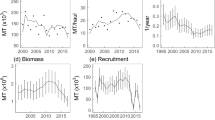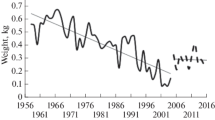Abstract
We examined growth of northern shrimp Pandalus eous in the Sea of Japan, off western Hokkaido, to improve estimations of catch-at-age for stock assessment. Multiple length frequency analysis based on length frequency data collected by a scientific research vessel was conducted to examine length-at-age in the shrimp population. Multi-normal distributions estimated using maximum likelihood indicated a good fit to length distributions. AIC values and regression analyses revealed annual growth variation and a decreasing trend in the length at several age classes in the shrimp population. We revised the method for estimating catch-at-age from the age-conversion table (ACT), which is a simple method for age determination, to age–length keys (ALK) calculated from the results of multiple length frequency analysis. Abundant year classes caught successively year after year could be more easily identified from the catch-at-age data computed using ALK than by using ACT. Our results suggested not only that the mean size of commercial landings fluctuated based on changes in age composition but also that a decrease in the length-at-age in the population influenced the consistent size decrease of commercial landings.











Similar content being viewed by others
References
Rochet M, Trenkel V (2003) Which community indicators can measure the impact of fishing? A review and proposals. Can J Fish Aquat Sci 60:86–99
Hilborn R, Walters CJ (1992) Quantitative fisheries stock assessment: choice, dynamics, and uncertainty. Chapman & Hall, New York
Prager MH (1994) A suite of extensions to nonequilibrium surplus-production model. Fish Bull US 90:374–389
Gulland JA (1965) Estimation of mortality rates. Annex to Arctic Fisheries Working Group Report. ICES CM 1965. Doc 3. International Council for the Exploration of the Sea, Copenhagen
Pope CJ (1972) An investigation of virtual population analysis using cohort analysis. Int Comm Northwest Atl Fish Res Bull 9:65–74
Westrheim S, Ricker WE (1978) Bias in using an age–length key to estimate age-frequency distribution. J Fish Res Board Can 35:184–189
Kimura DK, Chikuni S (1987) Mixtures of empirical distributions: an iterative application of the age–length key. Biometrics 43:23–35
Nakame Y (1991) Reproductive cycle and growth of pink shrimp, Pandalus borealis, around Musashi Bank in Japan Sea off Hokkaido, Japan. Sci Rep Hokkaido Fish Exp Stn 37:5–16 (in Japanese with English abstract)
Sadakata T (1999) On the growth of northern shrimp Pandalus eous in the waters off Noto Peninsula, the Sea of Japan. Nippon Suisan Gakkaishi 65:1010–1022 (in Japanese with English abstract)
Nakame Y, Mitsuhashi M (1993) Shrimps. Annual report of Hokkaido Wakkanai Fisheries Research Institute (fiscal year 1992), pp 38–67 (in Japanese)
Sküladóttir U (1998) Size at sexual maturity of female northern shrimp (Pandalus borealis Krøyer) in the Denmark Strait 1985–93 and a comparison with the nearest Icelandic shrimp populations. J Northwest Atl Fish Sci 24:27–37
Koeller P, Covey M, King M (2003) Is size at sex transition an indicator of growth or abundance in pandalid shrimp? Fish Res 65:217–230
Wieland K (2004) Length at sex transition in northern shrimp (Pandalus borealis) off West Greenland in relation to changes in temperature and stock size. Fish Res 69:49–56
Wieland K (2005) Changes in recruitment, growth, and stock size of northern shrimp (Pandalus borealis) at West Greenland: temperature and density-dependent effects at released predation pressure. ICES J Mar Sci 62:1454–1462
Koeller P, Fuentes-Yaco C, Platt T (2007) Decreasing shrimp (Pandalus borealis) sizes off Newfoundland and Labrador—environment or fishing? Fish Oceanogr 16:105–115
Fuentes-Yaco C, Koeller P, Sathyendranath S, Platt T (2007) Shrimp (Pandalus borealis) growth and timing of the spring phytoplankton bloom on the Newfoundland–Labrador Shelf. Fish Oceanogr 16:116–129
Tanaka S (1956) A method of analysing the polymodal frequency distribution and its application to the length distribution of Porgy, Taius tumifrons (T. & S.). Bull Tokai Reg Fish Res Lab 14:1–13 (in Japanese with English abstract)
Macdonald PDM, Pitcher TJ (1979) Age-groups from size-frequency data: a versatile and efficient method of analysing distribution mixtures. J Fish Res Board Can 36:987–1001
Pauly D (1987) A review of the ELEFAN system for analysis of length-frequency data in fish and aquatic invertebrates. In: Pauly D, Morgan DR (eds) Length-based methods in fisheries research. ICLARM Conf Proc No. 13, Manila, pp 7–34
Fournier DA, Sibert JR (1990) MULTIFAN a likelihood-based method for estimating growth parameters and age composition from multiple length frequency data sets illustrated using data for southern bluefin tuna (Thunnus maccoyii). Can J Fish Aquat Sci 47:301–317
Yamakawa T, Matsumiya Y (1997) Simultaneous analysis of multiple length frequency data sets when the growth rates fluctuate between years. Fish Sci 63:708–714
Tanaka E, Tanaka S (1990) A method for estimating age-composition from length-frequency by using stochastic growth equation. Nippon Suisan Gakkaishi 58:1209–1218
Akamine T (2005) Mixture of normal distributions and EM algorithm. Bull Jpn Soc Fish Oceanogr 69:174–183 (in Japanese with English abstract)
Gorie S (2002) Estimation of parameters in a mixture of normal distributions from length frequency composition and growth formula by MS-EXCEL. Suisanzoshoku 50:243–249 (in Japanese with English abstract)
Sadakata T (2004) On the population structure and sex change of northern shrimp Pandalus eous in the waters off Noto Peninsula, the Sea of Japan—studies on the fishery management of northern shrimp Pandalus eous in the waters off Noto Peninsula, the Sea of Japan IV. Nippon Suisan Gakkaishi 70:131–137 (in Japanese with English abstract)
Smith M, Addison J (2003) Methods for stock assessment of crustacean fisheries. Fish Res 65:231–256
Haedrich R, Barnes S (1997) Changes over time of the size structure in an exploited shelf fish community. Fish Res 31:229–239
Kojima I, Yorita T, Ueno T (1969) Fishing grounds and some biological observations of shrimps off Ishikari Bay, Hokkaido. Sci Rep Hokkaido Fish Exp Stn 11:30–40 (in Japanese with English abstract)
Ju SJ, Sector DH, Harvey HR (2001) Growth variability and lipofuscin accumulation rates in the blue crab Callinectes sapidus. Mar Ecol Prog Ser 224:197–205
Kodama K, Yamakawa T, Shimizu T, Aoki I (2005) Age estimation of the wild population of Japanese mantis shrimp Oratosquilla oratoria (Crustacea: Stomatopoda) in Tokyo Bay, Japan, using lipofuscin as an age marker. Fish Sci 71:141–150
Kilada R, Sainte-Marie B, Rochette R, Davis N, Vanier C, Campana S, Gillanders B (2012) Direct determination of age in shrimps, crabs, and lobsters. Can J Fish Aquat Sci 69:1728–1733
Yamaguchi H, Nishiuchi S, Takayanagi S, Miyashita K (2011) Shrimp-pot mesh selectivity for northern shrimp Pandalus eous and the effect on commercial catch of increasing the mesh size of the shrimp pot, off western Hokkaido, the Sea of Japan. Nippon Suisan Gakkaishi 77:809–821 (in Japanese with English abstract)
Acknowledgments
We would like to thank the crew of “Hokuyo-maru”, scientific research vessel of Wakkanai Fisheries Research Institute, Hokkaido Research Organization, for their support in the shrimp-pot survey. We also thank Dr. H. Miyake, Dr. O. Shida and Dr. K. Baba, Central Fisheries Research Institute, Hokkaido Research Organization for many helpful comments. We are grateful to the shrimp scientists in Hokkaido Research Organization for their successive data collection.
Author information
Authors and Affiliations
Corresponding author
Rights and permissions
About this article
Cite this article
Yamaguchi, H., Goto, Y., Hoshino, N. et al. Growth and age composition of northern shrimp Pandalus eous estimated by multiple length frequency analysis. Fish Sci 80, 665–678 (2014). https://doi.org/10.1007/s12562-014-0758-2
Received:
Accepted:
Published:
Issue Date:
DOI: https://doi.org/10.1007/s12562-014-0758-2




